
Oncology NEWS International
- Oncology NEWS International Vol 9 No 8
- Volume 9
- Issue 8
High Toxic Death Rate Closes Paclitaxel Plus EP Study Early
HERAKLION, Greece-A multicenter randomized phase III study comparing paclitaxel (Taxol)/etoposide/cisplatin (Platinol) (TEP) with standard-therapy etoposide/cisplatin (EP) in patients with small-cell lung cancer (SCLC) was stopped prematurely due to a 13% toxic death rate, according to a report given at the 36th Annual Meeting of the American Society of Clinical Oncology (ASCO).
HERAKLION, GreeceA multicenter randomized phase III study comparing paclitaxel (Taxol)/etoposide/cisplatin (Platinol) (TEP) with standard-therapy etoposide/cisplatin (EP) in patients with small-cell lung cancer (SCLC) was stopped prematurely due to a 13% toxic death rate, according to a report given at the 36th Annual Meeting of the American Society of Clinical Oncology (ASCO).
TEP and EP regimens have comparable activity as first-line treatment in small-cell lung cancer. However in the TEP arm, there were eight toxic deaths vs none in the EP arm (P = .001), reported Dimitrios Mavroudis, MD, of the University General Hospital of Heraklion, for the Greek Lung Cancer Cooperative Group.
In addition to the deaths, patients in the TEP arm suffered more severe neutropenia, thrombocytopenia, diarrhea, asthenia, and neurotoxicity.
The unexpected high toxic rate in the study by Mavroudis and the small sample size preclude any meaningful comparisons in terms of response rate and survival at this point, said Giuseppe Giaccone, MD, PhD, who commented on Dr. Mavroudiss report at the ASCO session.
Four of the toxic deaths were due to neutropenic sepsis. One death each was due to grade 4 diarrhea with possible sepsis, stroke with cytopenias, pneumonia (day 10), and sudden death (day 7).
Based on the excessive toxicity, and the result of an early interim analysis triggered by that toxicity, we decided to terminate the study, Dr. Mavroudis said.
The deaths were evenly divided (four each) between limited-disease patients and extensive-disease patients. Two deaths occurred in patients with initial World Health Organization (WHO) performance status of 0, four deaths in patients with a performance status of 1, and two deaths in patients with a performance status of 2.
Dr. Giaccone urged caution in relying too heavily on phase II data from a single institution before launching a phase III trial. This is not the first time that we have had surprises in going to randomization in large multicenter trials, he said.
Phase I and II studies had suggested that the TEC combination was safe and highly effective in SCLC, Dr. Mavroudis pointed out. [J Clin Oncol 17:2309, 1999; and Semin Oncol 24(4 suppl 12): S144-148, 1997.] Based on the phase I and phase II studies, the toxic death rate was expected to be low. We were surprised with the high toxic death rate, he said.
Not a Unique Finding
Other groups have also reported a high toxic death rate with the three-drug TEC combination, Dr. Mavroudis observed. The SWOG (Southwest Oncology Group) study last year reported a toxic death rate of 10%. In the final analysis this year, it came down to 7%. So its not a unique finding in our study that the three-drug combination, at the doses used in this study, is toxic.
Dr. Mavroudis speculated that to make the TEP regimen safer, the paclitaxel dose needs to be decreased or carboplatin (Para-platin) needs to be substituted for cisplatin. The study from M.D. Anderson, which had only two toxic deaths, used a lower dose of paclitaxel, he noted.
Corey Langer, MD, co-chair of the ASCO oral abstract session, offered another theory to explain the difference in the toxic death rate between the Greek study and the ongoing SWOG study.
There may be subtle differ-ences in the types of patients that go on cooperative group studies in Greece compared to North America, Dr. Langer said in an ONI interview.
He added: We still want to know whether paclitaxel adds anything to the standard regimen, and that study did not answer that. A similar ongoing Intergroup study virtually recapitulates the Greek trial, and, to date we have not observed an untoward incidence of adverse events or treatment-related fatalities.
Study Design
The 133 patients in the Greek trial were randomized to receive either TEP or EP, with 62 patients receiving TEP and 71 receiving EP. The patients assigned to the TEP regimen received paclitaxel 175 mg/m² IV given over 3 hours on day 1, cisplatin 80 mg/m² IV on day 2, and etoposide 80 mg/m² IV on days 2 to 4 with prophylactic G-CSF (Neupogen) 5 µg/kg/d SC on days 5 to 15 for all patients. Cycles were repeated every 4 weeks.
Patients assigned to the EP regimen received paclitaxel 80 mg/m² IV on day 1 and etoposide 120 mg/m² IV on days 1 to 3 with G-CSF only for patients developing severe neutropenia.
A total of 547 cycles of treatment were administered (241 TEP, 306 EP) with a median of 4 and 5 cycles/patient, respectively.
Toxicity Results
All patients were evaluable for toxicity. In the TEP arm, 49 patients were evaluable for response, and 69 patients were evaluable for response in the EP arm. Limited-stage disease was present in 29 patients (47%) on TEP and 30 patients (42%) on EP.
National Cancer Institute grade 3-4 neutropenia occurred in 44% of the patients in the TEC arm vs 39% in the EP arm. Grade 3-4 thrombocytopenia occurred in 18% of the patients in the TEP arm vs 6% in the EP arm.
Grade 3 diarrhea occurred in 8% of patients in the TEP arm vs none in the EP arm. Grade 3-4 asthenia occurred in 11% of patients in the TEP arm vs 3% of patients in the EP arm. Grade 3 neurotoxicity occurred in 8% of patients in the TEP vs 1.4% of patients in the EP arm.
The primary endpoint was overall response rate and not survival, Dr. Mavroudis said. The study was designed to compare the activity and toxicity of TEP vs EP in previously untreated patients with small-cell lung cancer.
Response and survival differences between these two arms were not significant. In the TEP arm, 2 patients (3%) had a complete response, and 29 (47%) had a partial response. The median duration of response was 7 months, median survival was 10.5 months, and 1-year survival was 45.7%.
For the EP arm, 3 patients (4%) had a complete response, and 31 (44%) had a partial response. Median duration of response was 6 months, median survival was 11.5 months, and 1-year survival was 45.7%.
Looking at the duration of the response, survival, and 1-year survival, there was no statistically significant difference between TEP and EP, Dr. Mavroudis said.
In the subgroup analysis, TEP was more active than EP in patients with extensive disease (P = .03) but with no survival benefit.
In an intention-to-treat subgroup analysis of responses based upon the stage of disease, looking at the complete and partial remission rate, duration of response, time to progression, and overall survival, there was no statistically significant difference between the two arms, either in limited- or extensive-stage disease. All the P values were nonsignificant, Dr. Mavroudis said.
Articles in this issue
over 25 years ago
Scientists Identify Gene Mutations in Multiple Myelomaover 25 years ago
Single-Agent Herceptin Active in Metastatic Breast Cancerover 25 years ago
Brain Metastases Respond to Paclitaxel, Carboplatin, and Brain RTNewsletter
Stay up to date on recent advances in the multidisciplinary approach to cancer.















































































